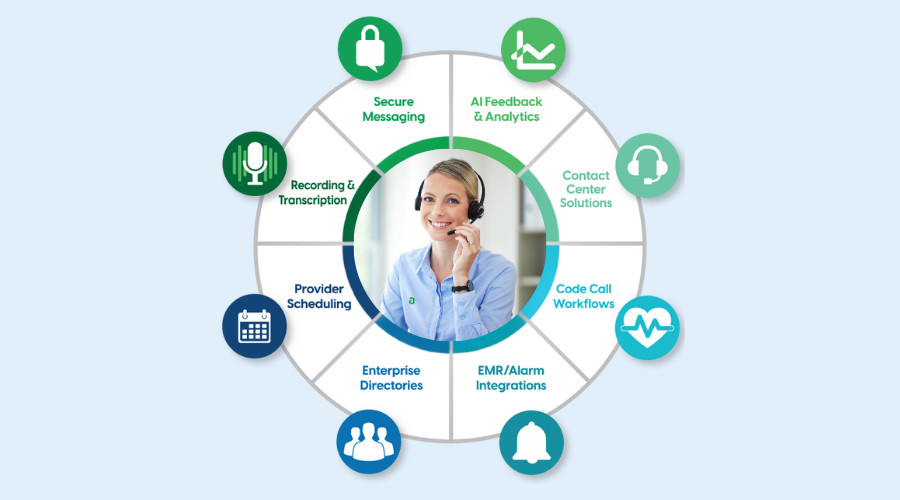The coronavirus outbreak has highlighted the importance of minimizing the spread of germs and the ability to socially distance themselves from others. The use of mobile communication technology in hospitals and clinics has given healthcare workers a way to coordinate care when they are physically away from their co-workers and patients.
Care teams can collaborate on care plans quickly and accurately with the right technology that offers interoperability between disparate systems. When web-based communication tech is part of an organization’s communication protocol, hospital staff from different departments, or even different locations, can access the information they need at any time from virtually any place.
Using Apps for Mobile Hospital Staff
Web-based communication makes it possible for a hospital to employ remote staff. Applications ensure fast, secure, communications, adds efficiencies, and improve care team communication. Mobile-friendly applications, such as miTeamWeb, can be used via a PC, smartphone, or tablet to make it possible for medical staff to interact remotely by accessing on-call schedules, directories, messages, and reports. miTeamWeb lets users coordinate and send messages via:
- Amtelco Secure Messages (secure mobile app)
- Pager (WCTP, SNPP, TAP)
- SMS
- Vocera
- Cisco wireless phones
- Fax
Using a secure messaging app protects patient health information (PHI) while the staff is communicating on the go. End-to-end encrypted apps that are HIPAA and HITECH-compliant can be used by medical personnel to easily send and receive texts, voice messages, photos, and audio files containing PHI. Messages are sent quickly and securely via any smart device or web-enabled computer.
Some apps like Amtelco Secure Messages can even use native integration engine software to seamlessly integrate with other software used in healthcare facilities to communicate notifications and alarms from nurse call, monitoring, and smart bed systems, directly to medical staff.
Operators Work From Home During the Pandemic
Remote operators are playing a crucial role for hospitals during the pandemic. Hospital call centers are the hub of a healthcare organization’s communications and are oftentimes a crucial part of care team communication. Call centers can run in a virtual server environment, or in the cloud, to give their agents the ability to work from home.
“We played an immediate role in the hospital’s corporate response to the coronavirus pandemic,” explains Shelley White, Director of Patient Access Services for State University of New York (SUNY) Upstate Medical University. “A COVID-19 hotline was established and we took calls from multiple counties in our area. Our call volume drastically increased, and we needed more space in our call centers to work while practicing social distancing. We set up additional remote operator workstations so more of our agents could work from home. This kept our staff safe while serving the community.”
The tools to achieve this are scalable and offer fully functioning call handling to transform any personal computer or laptop into a professional telephone agent station that can be accessed through the Internet or a local intranet.
A cloud-based messaging system is omnichannel and offers flexibility and efficiency. A VPN connection is established for remote operators to ensure their connection is secure. The data connection can be established via direct connection, remote desktop, thin client, Citrix, and VDI; and an audio connection via integrated audio or external audio.
Jennie McWhorter, Information Services Operations Manager for Ephraim McDowell Health in Danville, KY is having her staff use Amtelco’s Soft Agent software at home through a VPN connection. She says, “This is happening without a remote audio connection. The new version of Soft Agent allows us to handle audio both ways without an external audio source.”
News and procedures regarding the coronavirus outbreak are happening quickly. Custom call center scripting guides remote operators through each call with the exact information they need to provide about the latest information regarding COVID-19. The ability to easily edit scripting protocols means frontline operators, working from any location, will know the most up-to-date information to provide the best caller experience and reduce errors or misinformation.
Shelley’s team has also been able to assist staff who are still located within the hospital. SUNY Upstate Medical University is the only ACS-certified Level I Trauma Center in the region and serves about 1.7 million people and 28 referral hospitals. Shelley says, “During this coronavirus crisis, our ER registration can be short-staffed, but we are able to help by watching our track board, which is tied into the EMR system with Epic. When a COVID-19 patient is admitted, we can call the patient to register them and verify insurance information over the phone. This process would normally be done in-person by ER staff, but we can do it remotely and ease some of their workloads.”
Shelley is confident in her operators and their ability to serve the community while working remotely, “SUNY Upstate Medical University is doing well during this COVID-19 crisis. We were able to smooth workflow peaks and valleys and went from being overwhelmed with calls at the beginning of this situation, to having improved call metrics. We’ve been a community leader in so many ways, making everyone very proud. Our ability to rapidly adjust our call centers was instrumental in that response.”





